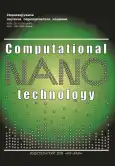Simulation of Aggregation Process in Cerium and Zirconium Dioxide Nanoparticles
- Autores: Voronin M.E.1, Gavrilova N.N.1, Koltsova E.M.1, Zhensa A.V.1
-
Afiliações:
- Mendeleev University of Chemical Technology of Russia
- Edição: Volume 9, Nº 3 (2022)
- Páginas: 73-79
- Seção: Articles
- URL: https://journals.eco-vector.com/2313-223X/article/view/529877
- DOI: https://doi.org/10.33693/2313-223X-2022-9-3-73-79
- ID: 529877
Citar
Texto integral
Resumo
Palavras-chave
Texto integral
Sobre autores
Mikhail Voronin
Mendeleev University of Chemical Technology of Russia
Email: mvoroninmsc@gmail.com
postgraduate student at the Department of Information Computer Technologies Moscow, Russian Federation
Natalia Gavrilova
Mendeleev University of Chemical Technology of Russia
Email: gavrilova.n.n@muctr.ru
Dr. Sci. (Chem.), Associate Professor; associate professor at the Department of Colloid Chemistry Moscow, Russian Federation
Eleonora Koltsova
Mendeleev University of Chemical Technology of Russia
Email: koltsova.e.m@muctr.ru
Dr. Sci. (Eng.), Professor; Head at the Department of Information Computer Technologies Moscow, Russian Federation
Andrey Zhensa
Mendeleev University of Chemical Technology of Russia
Email: zhensa.a.v@muctr.ru
Cand. Sci. (Eng.), Associate Professor; associate professor at the Department of Information Computer Technologies Moscow, Russian Federation
Bibliografia
- Trovarelli A. Catalytic properties of ceria and CeO2-containing materials. Catalysis Reviews. 1996. Vol. 38. No. 4. Pp. 439-520.
- Derjaguin B.V., Landau L.D. Theory of stability of strongly charged lyophobic sols and adhesion of strongly charged particles in electrolyte solutions. JETP. 1941. Vol. 11. No. 2. 802 p.
- Verwey E.J.W., Overbeek J.T.G. Theory of the stability of lyophobic colloids. Journal of Colloid Science. 1955. Vol. 10. No. 2. Pp. 224-225.
- Bhattacharjee S., Elimelech M., Borkovec M. DLVO Interaction between colloidal particles: Beyond Derjaguin’s approximation. Croatica Chemica Acta. 1998. Vol. 71. No. 4. Pp. 883-903.
- Bostrцm M., Deniz V., Franks G.V., Ninham B.V. Extended DLVO theory: Electrostatic and non-electrostatic forces in oxide suspensions. Chemical Advances in Colloid and Interface Science. 2006. Vol. 123-126. Pp. 5-15.
- Derjaguin B.V., Сhuraev N.V. Structural component of disjoining pressure of thin layers of liquids. Croat. Chem. Acta. 1977. Vol. 50. No. 1-4. P. 187. (In Rus.)
- Churaev N.V. Surface forces and physicochemistry of surface phenomena.Russian Chemical Reviews. 2004. Vol. 73. No. 1. Pp. 25-36. (In Rus.)
- Deryagin B.V. Theory of stability of colloids and thin films. Moscow: Nauka, 1986. 206 p.
- Deryagin B.V., Churaev N.V., Muller V.M. Surface Forces. 1985. 220 p.
- Derjaguin B.V. Stability of colloidal systems. Advances in Chemistry. 1979. Vol. 48. No. 4. Pp. 675-721. (In Rus.)
- Churaev N.V., Derjaguin B.V. Inclusion of structural forces in the theory of stability of colloids and films. Journal of Colloid and Interface Science. 1985. Vol. 103. No. 2. Pp. 542-553. (In Rus.)
- Golikova E.V. The role of boundary layers of water in the stability of disperse systems: Dis.. Cand. of Sci. (Chem.). 2004. 436 p.
- Kafarov V.V., Dorokhov I.N., Koltsova E.M. System analysis of chemical technology processes: Mass crystallization. Moscow: Yurayt Publishing House, 2018. 368 p.
- Prigozhin I., Stengers I. Order out of chaos. Man’s new dialogue with nature. Transl. from Eng. 2014. 304 p.
- Prigozhin I. From existing to emerging. 2006. 291 p.
- Glensdorf P., Prigozhin I. Thermodynamic theory of structure, stability and fluctuations. 2003. 280 p.
- Koltsova E.M., Gordeev L.S. Synergetics in chemistry and chemical technology. Moscow: Yurayt Publishing House, 2018. 295 p.
- Koltsova E.M., Tretyakov Yu.D., Gordeev L.S., Vertegel A.A. Nonlinear dynamics and thermodynamics of irreversible processes in chemistry and chemical technology. Moscow: Khimiya, 2001.
- De Groot S.R., Mazur P. Non-equilibrium thermodynamics. Courier Corporation, 2013.
- Kafarov V.V., Dorokhov I.N., Koltsova E.M. System analysis of chemical technology processes: Methods of non-equilibrium thermodynamics. Moscow: Yurayt Publishing House, 2018. 367 p.
- Marcelja S., Radic N. Repultion of interfaces due to boundary water. Chem. Phys. Lett. 1976. Vol. 42. No. 1. P. 129.
- Novikova N.A. Kinetics of coagulation of monodisperse silica sol in electrolyte: Dis.. Cand. of Sci. (Chem.). 2016. 143 p.
- Gavrilova N.N. Synthesis and colloid-chemical properties of CeO2-ZrO2 hydrosols: Dis.. Cand. of Sci. (Chem.). 2009. 146 p.
Arquivos suplementares











